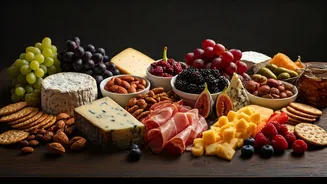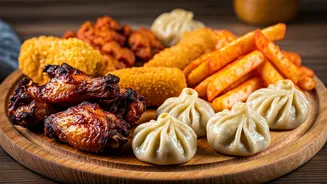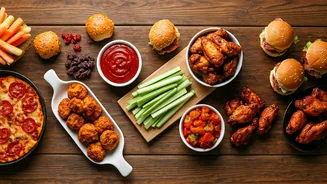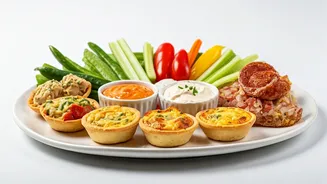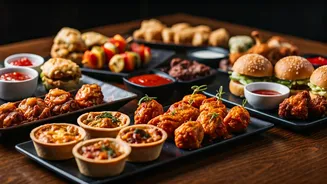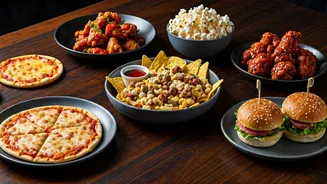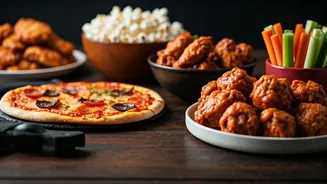Variety of Textures
The initial step to crafting an outstanding charcuterie board involves focusing on diverse textures, colours, and tastes. This foundational principle is crucial.
Consider incorporating a range of elements. For instance, combine the crispness of crackers with the smoothness of soft cheeses. Include cured meats like salami and prosciutto, offering varied textures alongside pickles, olives, and fruits. Introduce creamy components, crunchy elements, and something with a bit of a bite. Think about the sensory experience you want to create, ensuring there's something to stimulate every palate. By thoughtfully including a range of colours, from vibrant reds and greens to the more subtle hues of cheeses and crackers, your board will be instantly more appealing and invite guests to dive in.
Seasonal Flavors and Touches
To further elevate your charcuterie board, integrating seasonal flavours and touches is key. During the holiday season, this could mean using cranberries, pomegranates, or figs. Incorporate cheeses that are specific to the season, like a spiced Gouda or a creamy brie with cranberry preserves. Include elements like candied nuts or dried fruits. Furthermore, the overall presentation can be enhanced through festive garnishes. Use sprigs of rosemary or fresh cranberries to add a holiday feel. Consider small decorative elements, like miniature ornaments or seasonal napkins, which can subtly reinforce the festive atmosphere, making the board a visual and gastronomic celebration of the season.
Holiday-Inspired Design
Going beyond mere ingredients, a festive, holiday-inspired design can significantly boost the impact of your charcuterie board. This means selecting a board that aligns with the theme of your event. If it's a holiday party, opt for a board with a shape or style that matches the occasion. Next, arrange the elements in a way that reflects the theme. For example, creating a Christmas tree shape with the food items or a wreath design can transform a basic board into a festive masterpiece. Don't be afraid to use themed serving utensils, like mini cheese knives with holiday-themed handles or cocktail forks for olives and pickles. The goal is to make the board visually appealing and seamlessly integrated into the overall festive décor.
Mini Boards Galore
Instead of opting for one large charcuterie board, the use of several mini boards brings an exciting and interactive element to the dining experience. Serving individual portions of charcuterie allows for better organisation, preventing overcrowding, and enabling variety. Create smaller boards with different themes, such as a cheese-focused board, a meat-centric selection, or a fruit-based arrangement. This method also caters to diverse dietary needs or preferences. Include vegan or gluten-free options on separate boards. The strategy also simplifies the flow of serving, as guests can easily access their selections without having to wait. This approach fosters a more interactive and enjoyable experience for your guests.
Grazing Table Magic
Expanding from individual boards, consider setting up a grazing table. This concept involves arranging a wide array of foods directly on a table, creating a visually impressive spread. Use different heights and depths to enhance the look. Place items on risers, tiered trays, or wooden blocks. This creates layers and visual interest, making the grazing table more inviting. Ensure each element is thoughtfully arranged, focusing on aesthetics and convenience for the guests. Group similar items together and provide serving utensils. Consider the occasion when choosing the foods. The grazing table is all about providing choice. It allows guests to mingle, interact, and discover new flavour combinations, making it ideal for large gatherings and creating a memorable experience.
Shapes With Meats
For a playful and eye-catching charcuterie board, experiment with creating shapes using the meats. This adds an element of fun and artistry to the presentation. Utilize salami, prosciutto, and other cured meats to shape flowers, stars, or even initials. Start by folding and arranging the meats in a creative way on the board. For example, salami can be folded into roses or arranged to form a circular design. Prosciutto can be draped and layered to create a ruffled effect. This technique not only adds a visual element but also showcases the meats' textures and flavours. These kinds of arrangements take a simple charcuterie board and turn it into a work of edible art, ensuring a memorable and unique experience for your guests.
Elevate with Garnishes
Finally, don’t neglect the significance of edible garnishes to finalize your charcuterie board. Garnishes can add a fresh and refined touch, while complementing the flavours and presentation. Fresh herbs, such as rosemary, thyme, or basil, can provide both visual appeal and a pleasant aroma. Consider using fresh fruits, such as grapes, berries, or slices of citrus, to introduce colour and freshness. Small portions of honey or jam placed strategically on the board also make for an attractive and flavourful addition. These elements contribute to the sensory experience, offering pops of colour and flavour that enhance the overall enjoyment and sophistication of the charcuterie board. They allow the host to inject their personality, making it even more special.


